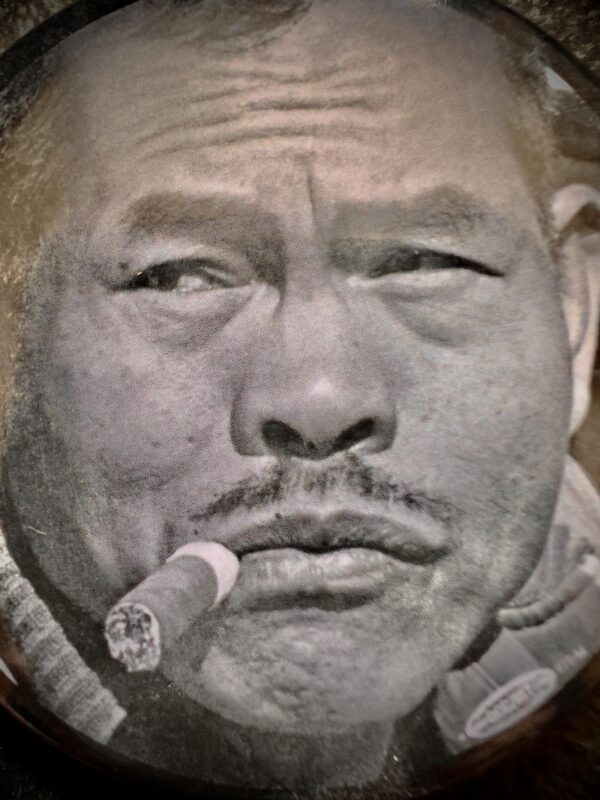A belated birthday greeting to Larry Itliong as Fil-Am History Month ends

LARRY Itiong. PHOTO SUPPLIED BY EMIL GUERRERO
Filipino-American History Month came to a close on Halloween night as I donned my ranch-style jean jacket and paraded around holding a bubble gum cigar with seven-fingers in honor of Larry Itliong, the lost and found labor leader of the famed Delano Grape Strike of 1965.
I say “lost and found” because Itliong is the modern Filipino-American universally loved by those who understand the automatic erasure of prominent Filipino-Americans in US. history. And now more and more people are finding out about Itliong, whose birthday would have been on Oct. 25.
He’s worth celebrating for more than one day.
Itliong’s Agricultural Workers Organizing Committee (AWOC/AFL-CIO) started the great Delano Grape Strike on Sept. 8, 1965 when growers refused to honor the union’s pay demand of $1.40 an hour.
Where was Cesar Chavez, the man whom history often calls the leader of the Delano Grape Strike? He had no idea a strike was called.
Itliong started it, but Itliong also knew the Filipinos, a group of workers in their 50s and 60s who came to America in the 1920s and 1930s, needed to be energized by the next wave of immigrants– from Mexico.
Chavez at the time had a group, the National Farmworkers Association, that when compared to Itliong’s union, was practically a book and social club.
But Itliong knew if he could get Chavez to join forces, they had a chance to win the fight in the fields. It was Itliong who made sure the merger would happen.
By Sept. 15, Chavez’s group joined and the United Farmworkers came into existence.
Itliong started it and stayed six years before leaving the UFW in 1971. He died in 1976 of ALS, a very rare degenerative disease.
In 2015, in celebration of the 50th anniversary of the strike, the Filipino-Amercan National Historical Society brought together key participants of the strike. But mostly it was done so the Chavez family could publicly acknowledge that Itliong and Filipinos were more than just silent, invisible partners in the UFW.
“Itliong was the one who made the decision for the negotiations between the NFWA and AWOC,” said Gilbert Padilla, a co-founder of Chavez’s NFWA. “Larry was the one who made sure we merged together.”
And then members of the Chavez family set the record straight.
“There are names lost in history, and today’s ceremony goes a long way of rectifying that,” said Paul Chavez, 58, the son of Cesar Chavez, who used to call Itliong, “Uncle Larry.”
“Of course, there were some hard feelings. Who would not be offended if they felt their contributions weren’t recognized,” Paul Chavez told me. “We should now look to recognize these unsung heroes.”
That was in 2015, the year California’s Gov. Jerry Brown set aside Itliong’s birthday, Oct. 25, as Larry Itliong Day. Though there is at least one school named for Itliong, there’s still a sense that not enough schools, parks, libraries and other public buildings commemorate the man who, in the grape strike, brought the civil rights and labor rights movement together.
That’s why I was in Larry Itliong drag, performing my Larry Itliong mini-monologues on Halloween night.
My favorite Larry speech comes from a lecture he gave at UC Santa Cruz in 1976.
Chavez may be famous for saying “Si se puede.”
Itliong should be famous for being fearless in his saying no.
He knew he didn’t have to go along with the powerful. And if he was offered money, he says he didn’t hesitate to turn it down.
“A lot want to buy me off,” Itliong told the students. “One of the biggest organizations that I grew up with in this country offered me $200,000.”
Itliong described the offer: “They said, Larry Itliong, we know you need money. You’re doing a good job in California. We’ll give you $200,000 to do whatever you want to do.”
But then he described the conditions.
The money would be his… “if you’re going to help Cesar Chavez run the service center,” he says on the tape. “Just the implication that I’m supporting Cesar Chavez, they want to give me $200,000.”
This was after he left the United Farm Workers early as a VP to Chavez. It was as if the union acknowledged Chavez needed Itliong to unify the two biggest groups in the fields, the Mexicans and the Filipinos.
“You know what I tell them,” he said. “I don’t need that $200,000. I can eat rice and pusit (squid), bagoong (anchovy paste), mango. I don’t need $200,000.”
He said young Pinoys with him were amazed at the time by his refusal.
“I said, $200,000 to sell out my countrymen?,” Itliong asked rhetorically. “I figure we have about 350,000 Filipinos in California. That’s only $200,000. That’s not even $1 dollar a head. No, I don’t want your money. If I want to sell my countrymen, then give me $50 million–I’ll take it.”
So Itliong did name his price, but as he told the story, he laughed with the students in the seminar. “Do you want to buy my countrymen, give me $50 million?”
These are the passionate words of Larry Itliong that make him the labor and civil rights leader worthy of our respect and adulation—something that eluded him most of his life. But no longer.
Not as long as we celebrate October as Filipino-American History Month every year.
Just remember whenever you see Chavez’s name or hear about the grape strike, don’t forget Manong Larry Itliong and the debt owed to Filipino Americans like him.
They made history in the fields.
(Emil Guillermo is a journalist and commentator who writes a column for the Inquirer.net’s US channel. His micro-talk show “Emil Amok’s Takeout” is on YouTube, and on www.amok.com)

